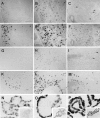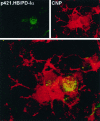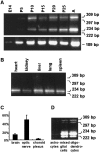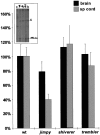Phosphodiesterase I, a novel adhesion molecule and/or cytokine involved in oligodendrocyte function
- PMID: 9364056
- PMCID: PMC6573621
- DOI: 10.1523/JNEUROSCI.17-23-09095.1997
Phosphodiesterase I, a novel adhesion molecule and/or cytokine involved in oligodendrocyte function
Abstract
One of the more complex developmental processes occurring postnatally in the CNS is the formation of the myelin sheath by oligodendrocytes. To examine the molecular events that take place during myelination, we isolated oligodendrocyte-derived cDNA clones, one of which (p421.HB) represents a putative alternatively spliced isoform of rat brain-specific phosphodiesterase I (PD-Ialpha) and a species homolog of the human cytokine autotaxin. Analysis of the structural composition of the p421.HB/PD-Ialpha protein suggests a transmembrane-bound ectoenzyme, which, in addition to the phosphodiesterase-active site contains presumed cell recognition and Ca2+-binding domains. Consequently, it may be involved in extracellular signaling events. Expression of p421.HB/PD-Ialpha is enriched in brain and spinal cord, where its mRNA can be detected in oligodendrocytes and in cells of the choroid plexus. Expression in the brain increases during development with an intermediate peak of expression around the time of active myelination and maximal expression in the adult. We have identified four presumably alternatively spliced isoforms, two of which appear to be CNS-specific. Decreased levels of p421.HB/PD-Ialpha mRNA in the dysmyelinating mouse mutant jimpy, but not shiverer, suggest a role for p421.HB/PD-Ialpha during active myelination and/or late stages of oligodendrocyte differentiation. Furthermore, p421.HB/PD-Ialpha mRNA levels were reduced in the CNS at onset of clinical symptoms in experimental autoimmune encephalomyelitis. These data together implicate the importance of p421.HB/PD-Ialpha in oligodendrocyte function, possibly through cell-cell and/or cell-extracellular matrix recognition.
Figures







Similar articles
-
Phosphodiesterase-Ialpha/autotaxin: a counteradhesive protein expressed by oligodendrocytes during onset of myelination.Mol Cell Neurosci. 2003 Jul;23(3):507-19. doi: 10.1016/s1044-7431(03)00073-3. Mol Cell Neurosci. 2003. PMID: 12837632
-
Glycerophosphorylcholine phosphocholine phosphodiesterase activity in cultured oligodendrocytes, astrocytes, and central nervous tissue of dysmyelinating rodent mutants.J Neurosci Res. 1992 Jan;31(1):68-74. doi: 10.1002/jnr.490310110. J Neurosci Res. 1992. PMID: 1319506
-
Phosphodiesterase-Ialpha/autotaxin (PD-Ialpha/ATX): a multifunctional protein involved in central nervous system development and disease.J Neurosci Res. 2005 Dec 15;82(6):737-42. doi: 10.1002/jnr.20686. J Neurosci Res. 2005. PMID: 16267828 Review.
-
Lysophosphatidic acid can support the formation of membranous structures and an increase in MBP mRNA levels in differentiating oligodendrocytes.Neurochem Res. 2009 Jan;34(1):182-93. doi: 10.1007/s11064-008-9772-z. Epub 2008 Jul 2. Neurochem Res. 2009. PMID: 18594965 Free PMC article.
-
Mechanical plasticity during oligodendrocyte differentiation and myelination.Glia. 2018 Jan;66(1):5-14. doi: 10.1002/glia.23206. Epub 2017 Sep 21. Glia. 2018. PMID: 28940651 Free PMC article. Review.
Cited by
-
Akt-mediated survival of oligodendrocytes induced by neuregulins.J Neurosci. 2000 Oct 15;20(20):7622-30. doi: 10.1523/JNEUROSCI.20-20-07622.2000. J Neurosci. 2000. PMID: 11027222 Free PMC article.
-
Autotaxin: a secreted autocrine/paracrine factor that promotes glioma invasion.J Neurooncol. 2008 Feb;86(3):297-309. doi: 10.1007/s11060-007-9480-6. Epub 2007 Oct 11. J Neurooncol. 2008. PMID: 17928955
-
Aiming drug discovery at lysophosphatidic acid targets.Br J Pharmacol. 2010 Sep;161(2):241-70. doi: 10.1111/j.1476-5381.2010.00815.x. Br J Pharmacol. 2010. PMID: 20735414 Free PMC article. Review.
-
Involvement of the lysophosphatidic acid-generating enzyme autotaxin in lymphocyte-endothelial cell interactions.Am J Pathol. 2008 Nov;173(5):1566-76. doi: 10.2353/ajpath.2008.071153. Epub 2008 Sep 25. Am J Pathol. 2008. PMID: 18818380 Free PMC article.
-
Expression of proteolipid protein gene in spinal cord stem cells and early oligodendrocyte progenitor cells is dispensable for normal cell migration and myelination.J Neurosci. 2014 Jan 22;34(4):1333-43. doi: 10.1523/JNEUROSCI.2477-13.2014. J Neurosci. 2014. PMID: 24453324 Free PMC article.
References
-
- Agresti C, D’Urso D, Levi G. Reversible inhibitory effects of interferon-γ and tumor necrosis factor-α on oligodendroglial lineage cell proliferation and differentiation in vitro. Eur J Neurosci. 1996;8:1106–1116. - PubMed
-
- Altschul SF, Gish W, Miller W, Myers EW, Lipman DJ. Basic local alignment search tool. J Mol Biol. 1990;215:403–410. - PubMed
-
- Baba H, Fuss B, Watson JB, Zane LT, Macklin WB. Identification of novel mRNAs expressed in oligodendrocytes. Neurochem Res. 1994;19:1091–1099. - PubMed
-
- Babu YS, Bugg CE, Cook WJ. Structure of calmodulin refined 2.2 Å resolution. J Mol Biol. 1988;204:191–204. - PubMed
-
- Barres BA, Hart IK, Coles HSR, Burne JF, Voyvodic JT, Richardson WD, Raff MC. Cell Death and control of cell survival in the oligodendrocyte lineage. Cell. 1992;70:31–46. - PubMed
Publication types
MeSH terms
Substances
Grants and funding
LinkOut - more resources
Full Text Sources
Other Literature Sources
Medical
Miscellaneous
